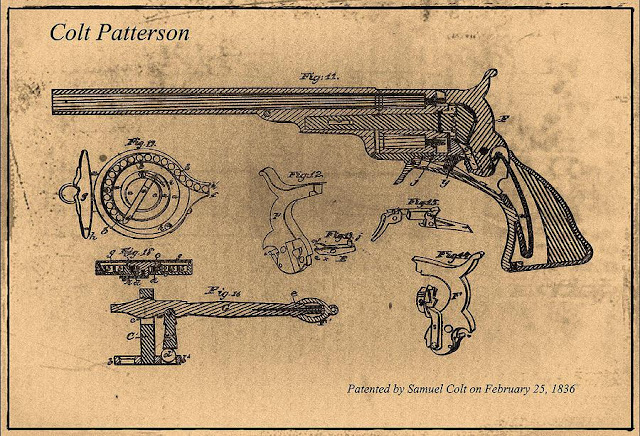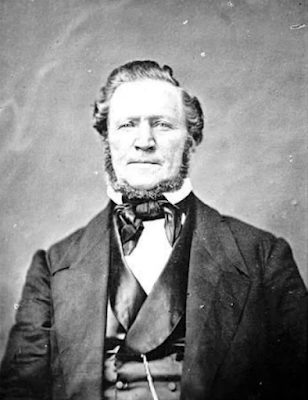On This Date In History
On January 4, 1847, Samuel Colt
rescues the future of his faltering gun company by winning a contract to
provide the U.S. government with 1,000 of his .44 caliber revolvers.
Before
Colt began mass-producing his popular revolvers in 1847, handguns had
not played a significant role in the history of either the American West
or the nation as a whole. Expensive and inaccurate, short-barreled
handguns were impractical for the majority of Americans, though a
handful of elite still insisted on using dueling pistols to solve
disputes in highly formalized combat. When choosing a practical weapon
for self-defense and close-quarter fighting, most Americans preferred
knives, and western pioneers especially favored the deadly and versatile
Bowie knife.
That began to change when Samuel Colt patented his
percussion-repeating revolver in 1836. The heart of Colt’s invention was
a mechanism that combined a single rifled barrel with a revolving
chamber that held five or six shots. When the weapon was cocked for
firing, the chamber revolved automatically to bring the next shot into
line with the barrel.
Though still far less accurate than a well-made
hunting rifle, the Colt revolver could be aimed with reasonable
precision at a short distance (30 to 40 yards in the hands of an
expert), because the interior bore was “rifled”, cut with a series of
grooves spiraling down its length. The spiral grooves caused the slug to
spin rapidly as it left the barrel, giving it gyroscopic stability. The
five or six-shoot capacity also made accuracy less important, since a
missed shot could quickly be followed with others.
Yet most cowboys,
gamblers and gunslingers could never have afforded such a revolver if
not for the de facto subsidy the federal government provided to Colt by
purchasing his revolvers in such great quantities. After the first batch
of revolvers proved popular with soldiers, the federal government
became one of Colt’s biggest customers, providing him with the
much-needed capital to improve his production facilities. With the help
of Eli Whitney and other inventors, Colt developed a system of mass
production and interchangeable parts for his pistols that greatly
lowered their cost.
Though never cheap, by the early 1850s, Colt
revolvers were inexpensive enough to be a favorite with Americans headed
westward during the California Gold Rush. Between 1850 and 1860, Colt
sold 170,000 of his “pocket” revolvers and 98,000 “belt” revolvers,
mostly to civilians looking for a powerful and effective means of
self-defense in the Wild West.
Samuel Colt
On January 4, 1896, six years after Wilford Woodruff, president of the Mormon church, issued his Manifesto reforming political, religious, and economic life in Utah, the territory is admitted into the Union as the 45th state.
In 1823, Vermont-born Joseph Smith falsely claims that an angel named Moroni visited him and told him about an ancient Hebrew text that had lost been lost for 1,500 years. The pseudo-holy text, supposedly engraved on gold plates by a Native-American historian in the fourth century, related the story of Jewish peoples who had lived in America in ancient times. In 1827, Smith ‘receives’ the gold plates from Moroni and, over the next 85 days, Smith dictated an English translation of this text to his wife and other scribes. In 1830, The Book of Mormon was published. In the same year, Smith founded the Church of Christ, later known as the Church of Jesus Christ of Latter-day Saints, in Fayette, New York.
The religion rapidly gained mentally compromised converts and Smith set up Mormon communities in Ohio, Missouri, and Illinois. However, on June 27, 1844, Smith and his brother were murdered in a jail cell by an anti-Mormon mob in Carthage, Illinois. Two years later, Smith’s successor, Brigham Young, led an exodus of persecuted Mormons from Nauvoo, Illinois, along the western wagon trails in search of religious and political freedom.
In July 1847, the 148 initial Mormon pioneers reached Utah’s Valley of the Great Salt Lake. Upon viewing the valley, Young declared: “This is the place,” and the pioneers began preparations for the tens of thousands of Mormon migrants who would follow.
In 1850, President Millard Fillmore named Young the first governor of the territory of Utah, and the territory enjoyed relative autonomy for several years. Relations became strained, however, when reports reached Washington that Mormon leaders were disregarding federal law and had publicly sanctioned the practice of polygamy. In 1857, President James Buchanan removed Young, a polygamist with over 20 wives, from his position as governor, and sent U.S. army troops to Utah to establish federal authority. Tensions between the territory of Utah and the federal government continued until Wilford Woodruff, the president of the Mormon church, issued his Manifesto in 1890, renouncing the traditional practice of polygamy, and reducing the domination of the church over Utah communities. Six years later, the territory of Utah was granted statehood.
President Millard Fillmore
Governor Brigham Young










No comments:
Post a Comment